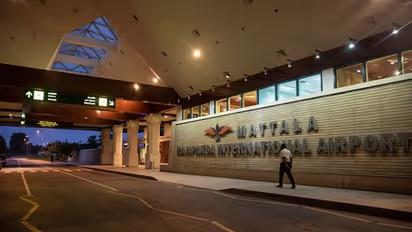Sri Lanka hands management of $209 million China-built airport to Indian and Russian companies

Synopsis
Sri Lanka has announced plans to hand over the management of its Mattala Rajapaksa International Airport (MRIA) to Indian and Russian companies, marking a strategic move to mitigate losses incurred by state enterprises.
Sri Lanka has announced plans to hand over the management of its Mattala Rajapaksa International Airport (MRIA) to Indian and Russian companies, marking a strategic move to mitigate losses incurred by state enterprises. The decision, revealed in a cabinet statement on Friday, aims to address financial challenges stemming from the airport's underutilization and controversial construction.
Since its inauguration in 2013, the $209 million MRIA, financed by China EXIM Bank, has faced criticism due to its limited flight operations, environmentally sensitive location, and ongoing financial deficits.
To revamp its operations, Sri Lanka has appointed Shaurya Aeronautics (Pvt) Ltd. of India and Airports of Regions Management Company of Russia to oversee the airport's management for a period of 30 years, as outlined in the cabinet statement. However, specific details regarding the deal's financial terms were not disclosed.
The decision to transfer management underscores Sri Lanka's efforts to address its economic challenges, including negotiations with China EXIM Bank to restructure the airport loan, part of a larger effort to manage the country's $4.2 billion debt incurred for various infrastructure projects.
The construction of MRIA took place during the tenure of former President Mahinda Rajapaksa, who notably fostered closer ties with China, diverging from Sri Lanka's traditional relationship with neighboring India. Situated in Rajapaksa's hometown, the airport has been emblematic of the geopolitical shifts within Sri Lanka's foreign policy.
The move to transfer management comes amidst Sri Lanka's financial turmoil, marked by a default on foreign debt in May 2022, following a depletion of foreign exchange reserves. The resulting financial crisis has been described as the most severe in over seven decades, prompting Sri Lanka to seek a $2.9 billion bailout from the International Monetary Fund (IMF).
With the IMF bailout in place, Sri Lanka has embarked on a path to stabilize its economy and regain growth momentum by 2024 after two years of economic downturn. As part of this endeavor, the Sri Lankan government is actively working to mitigate losses incurred by numerous state-owned enterprises, including the MRIA management restructuring aimed at optimizing operational efficiency and financial sustainability.
Check the Breaking News Today and Latest News from across India and around the world. Stay updated with the latest World News and global developments from politics to economy and current affairs. Get in-depth coverage of China News, Europe News, Pakistan News, and South Asia News, along with top headlines from the UK and US. Follow expert analysis, international trends, and breaking updates from around the globe. Download the Asianet News Official App from the Android Play Store and iPhone App Store for accurate and timely news updates anytime, anywhere.